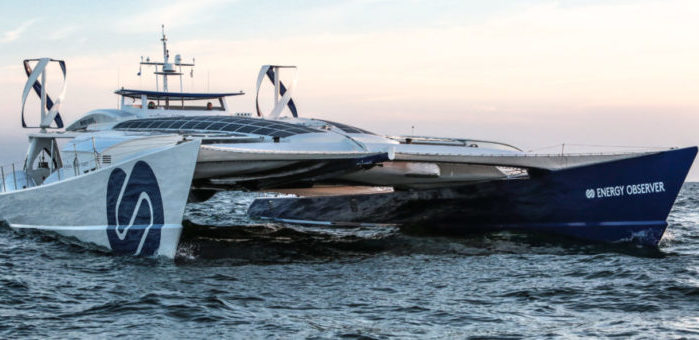Toyota has been participating in the Energy Observer project from the beginning, supporting the use of hydrogen, in line with its Environmental Challenge 2050 which represents the company’s green and sustainable ambitions.
Now, Toyota is launching its fuel cell technology in the boat. The technology uses components, which were firstly seen in the Toyota Mirai (a hydrogen fuel cell car), which have been fitted into a compact module suitable for marine reasons.
The technology will provide additional power efficiency and high reliability to cross the Atlantic and Pacific Ocean this year.
Specifically, the Energy Observer project was the world’s first hydrogen-powered vessel, which was a former race boat powered with autonomous navigation with hydrogen.
The vessel operates by using a mix or renewable energies and a system that produces carbon-free hydrogen from seawater.
[smlsubform prepend=”GET THE SAFETY4SEA IN YOUR INBOX!” showname=false emailtxt=”” emailholder=”Enter your email address” showsubmit=true submittxt=”Submit” jsthanks=false thankyou=”Thank you for subscribing to our mailing list”]
Also, the project detects and demonstrates positive initiatives and sustainable solutions to design tomorrow’s future, and to prove that a cleaner world is possible.
The European research and development (R&D) team conducted the design and component of the production in seven months, followed by the construction and installation of the compact fuel cell module.
At the end of 2019, the fuel cell module was trialled in the boat in the shipyard to ensure its efficiency, while the final power testing will take place at sea, prior to the Energy Observer sailing off for their 2020 Tour in the middle of February.
In middle 2019, the Energy Observer called the Port of Amsterdam, being its 35th stop, as it had began its journey from France in 2017 and is scheduled to visit Tokyo during the Olympic Games in 2020.
Concluding, Victorien Erussard, founder and captain of Energy Observer stated that
After three years and nearly 20,000 nautical miles of development, the Energy Observer energy supply and storage system is now very reliable and we look forward to the next step of the project: Get a reliable and affordable system available for our maritime community.






























































